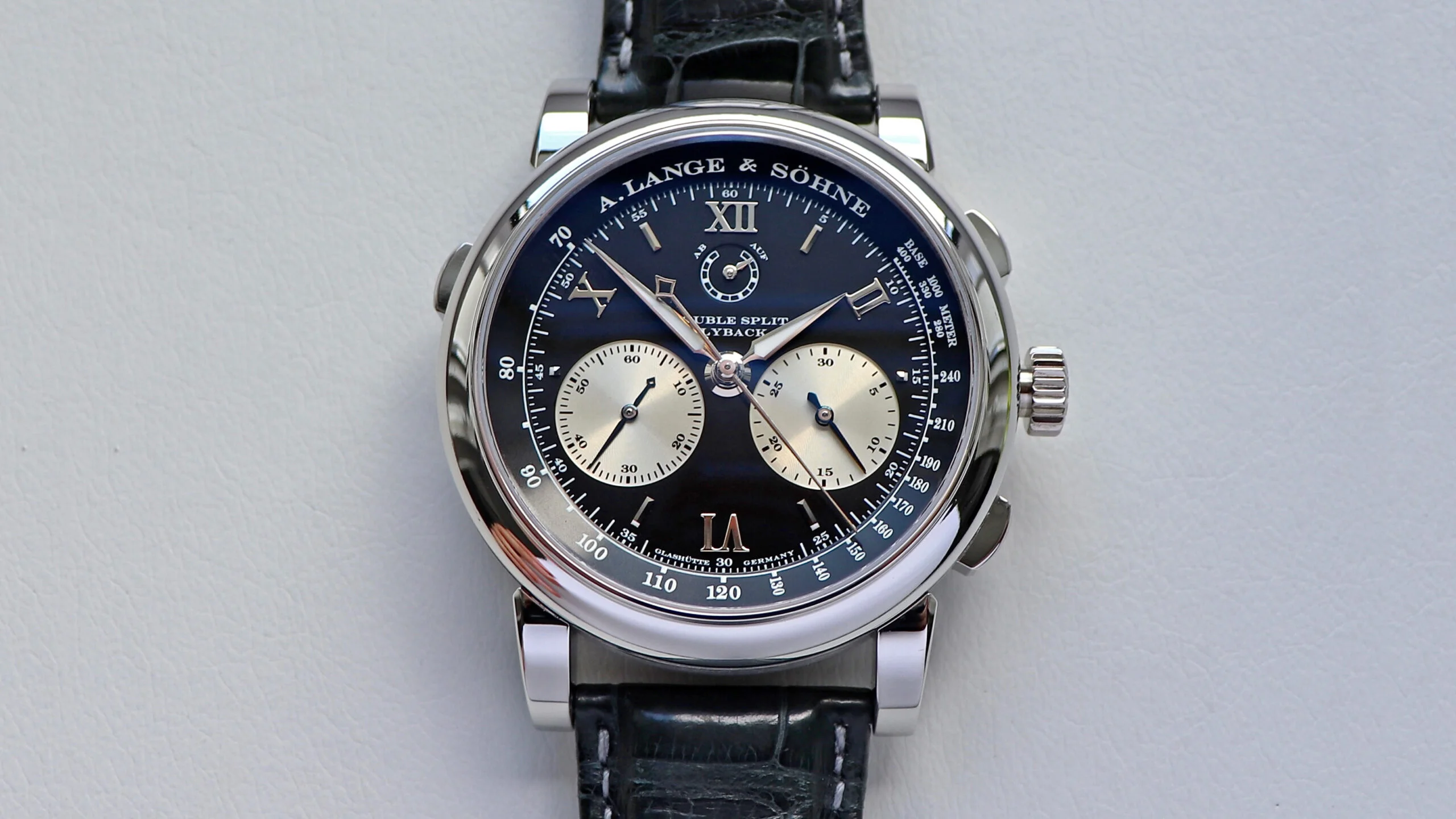
A. Lange & Söhne Double Split
The Collector’s Guide – October 2020
A marketing theory Blue Ocean Strategy, by the INSEAD professors Chan Kim and Renée Mauborgne, emphasizes the value innovation – differentiation with low cost to sail into uncharted waters where the innovator becomes the go to address for the newly developed product. It focuses on not to fight on a certain dimension, but rather conquering an area. Although the concept has major flaws in its offering as it seems to be descriptive rather than being prescriptive, I like this highly sticky concept of being the only one in a certain area and try to apply whenever possible. More importantly, I draw great similarities to the subject of the article: Double Split.
Quick Facts:
- Introduced in 2004
- The world’s first Double Rattrapante wristwatch
- Available in platinum, pink gold
- Measures 43.2 mm in diameter and 15.3 mm in thickness
- Received an aesthetic update in 2010
Brief History of Chronograph
The chronograph’s history goes centuries back to Louis Moinet, the inventor of the mechanism (he named it as compteur de tierces – please find more about it here) in 1816. It was a true chronograph in every sense of the word with impressive technical achievements. Subsequently, the chronograph was further developed by many other watchmakers. One example to note here is Joseph Thaddäus Winnerl – inventor of the split seconds chronograph mechanism who was also the tutor of Ferdinand Adolph Lange in Paris from 1835 to 1840.
Following century, the chronograph was perfected by the likes of Victorin Piguet. However, as might be unexpected for many today, it was Longines in 1913 who put the chronograph mechanism into a wristwatch with an in-house caliber 13.33Z for the first time. A staggeringly charming caliber crafted for the use of the rude military. Following, it was Breitling who patented the use of separate start, stop and reset buttons and again Longines incorporating the first flyback function in the late 1920s.
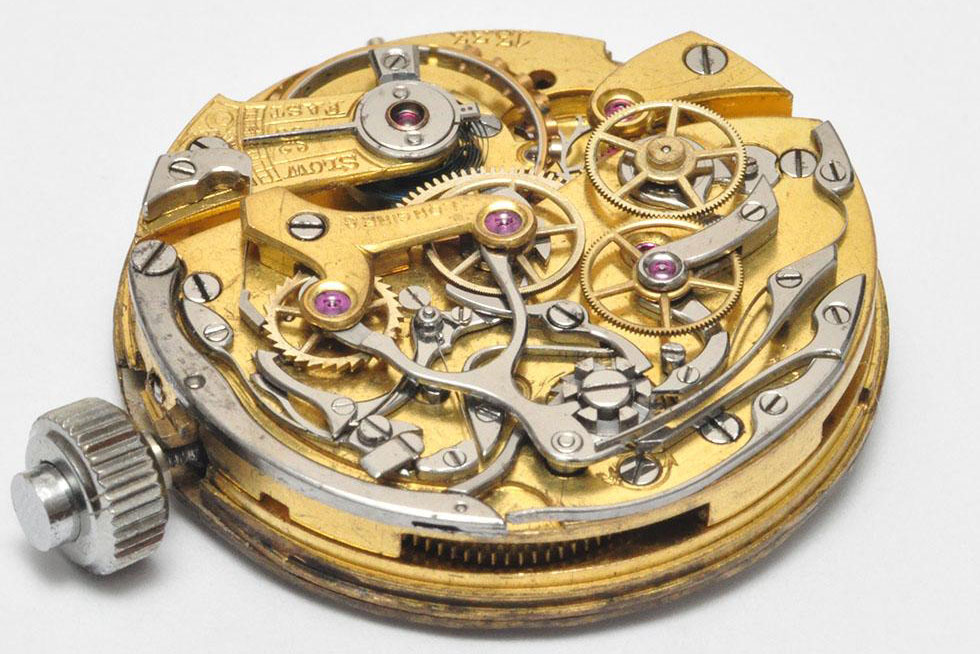
Throughout the next decades the manufacturers relied on outsourced movements for their most precious pieces. The name Valjoux has to be uttered here, as they were the one powering some of the most beautiful watches ever made from the period – including Patek Philippe’s famous 13-130 within the 1518. Towards the end 60s, the brands formed joint ventures to produce chronograph movements. El Primero from Zenith – Movado or The Chronomatic from the venture between Heuer, Breitling, Hamilton and the specialist Dépraz & Co…. However; the arrival of the quartz crisis put the brands into survival mode and kicked R&D out of the bedroom.
After the devastating crisis, the world had to wait until the late 1990s to see a newly developed chronograph caliber. This was Blümlein and his team exploiting an uncharted area and starting a new trend called in-house movement development. Following 9 short years after the re-birth, A. Lange & Söhne introduced the caliber L951.1 of the Datograph. To many, the most beautiful chronograph movement ever made. It was a complete surprise for almost everyone. How could a small German brand come up with such a complex and beautiful caliber where there are names like Patek Philippe, Audemars Piguet and Vacheron Constantin?
Albeit, only after a couple of years we learnt that A. Lange & Söhne had even bigger plans to change the game forever.
Double Split Platinum - 2004
Watchmaking is a legacy technology where working with the old methods is still celebrated. Apart from the societal hype and marketing surrounding the industry, certain brands and models, it is the human instinct that appreciates art, craft and nostalgia that breathes life into watchmaking. Even though the technology has enabled many advancements – minor and major – the basic principles for many applications used in watches today, be it the escapement or the complication construction such as chronograph, are centuries old.
Thus, in order to differentiate, every now and then brands unveil so called innovations. Alas, many fall into what I call just marketing gimmicks, contributing neither to longevity, nor accuracy. It is understandable, though. Modern mechanical watchmaking still has to function within the borders of nostalgia and mechanics; thus innovation brought to the watch industry is nothing but an incremental innovation, doing better what we already do. However, within these strict boundaries, some brands or watchmakers step up and manage to bring something extraordinary. One of them is A. Lange & Söhne’s Double Split.

A. Lange & Söhne introduced the Double Split in 2004. It is the world’s first double rattrapante chronograph; which means, in addition to the traditional split-seconds, it houses a second minute counter. Both pairs of hands can be stopped separately and the stopped hands can catch the running hands with a push. This unprecedented mechanical marvel came from a 15 years old start-up brand and was a clear message on what A. Lange & Söhne represents.
A Thick Case
Double Split is the reason for many watch enthusiasts to call A. Lange & Söhne’s watches as hockey pucks. Indeed, measuring at 43.2 mms in diameter and 15.3 mms in thickness with a signature solid, dense construction and heavily engineering inspired design, the watch deserves such moniker.
Lange Double Split’s lugs are rather short and thick, the bezel is concave to form a continuum to the tachymeter scale ring, and the caseback has that usual stepped construction – Lange’s design illusion especially utilized in thick watches. As a result, Double Split is certainly not the most comfortable watch in the world and rather impossible without a deployant buckle. Yet; for some who likes a “presence” there are not much better options.
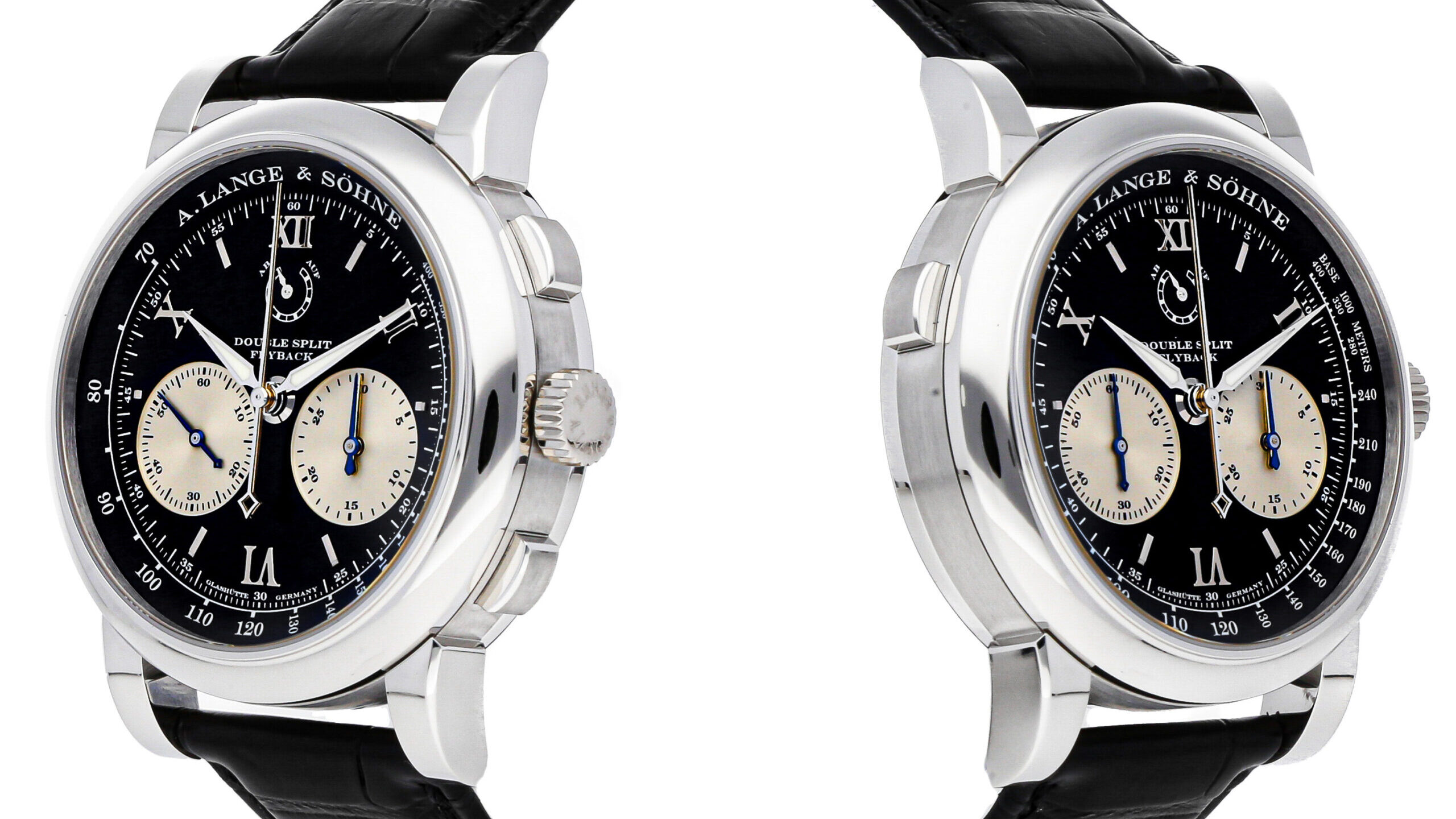
All in all, it is safe to say that the case is exceptionally engineered, most certainly meeting the Blümlein’s requirement of I want the owner to get the feeling of closing of a door of a Mercedes and Walt Odets’ infamous saying it is a watch (Saxonia) that only an engineer could love. The soldered lugs deliver a tactile feeling rather than a flowing romantic, further brings out the masculinity. Every detail spooking from the narrowest angles, and every bit either brushed or polished to form a strong contrast and flow through the band, the Double Split’s case is as magnificent as it is heavy.
As opposed to most other watches from the brand, the Double Split’s caseback is relief engraved; which further accentuates the depth and over-engineered nature of the watch just perfectly.
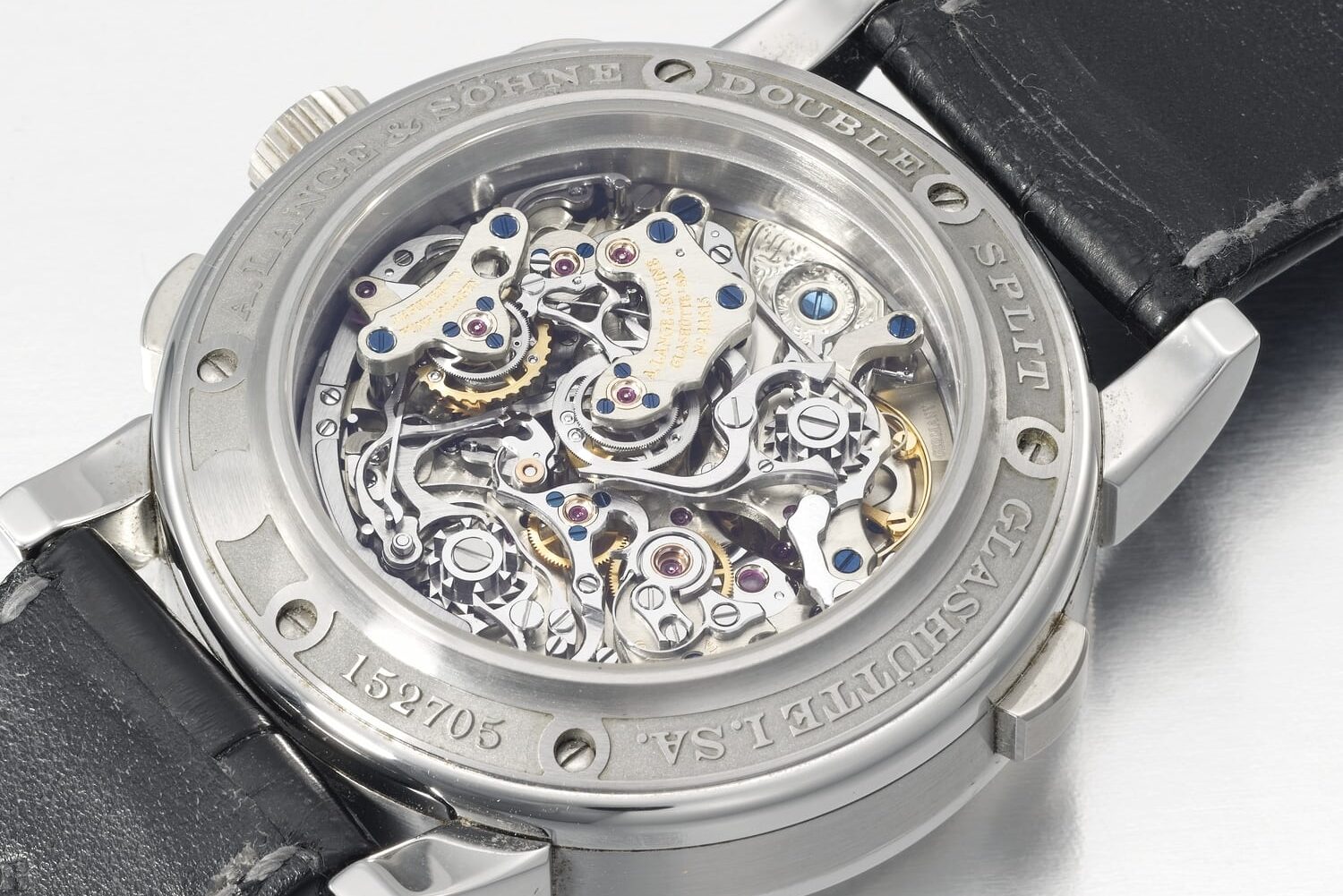
The lug width of the Double Split is 22ms and the buckle is 18 mms and it weighs around 200 grams even without the bracelet.
A Dial Deep as the Movement
Rather than being something entirely different, Double Split builds its identity over the original Datograph’s with great success. I think there are two reasons for such resemblance. First is the base movement constraints (more on that below) and the second one is that I believe A. Lange & Söhne wanted to build on the success of the original Datograph. Instead of offering a new line, they opted to attach the development to an already established identity, which is a great product launch strategy.
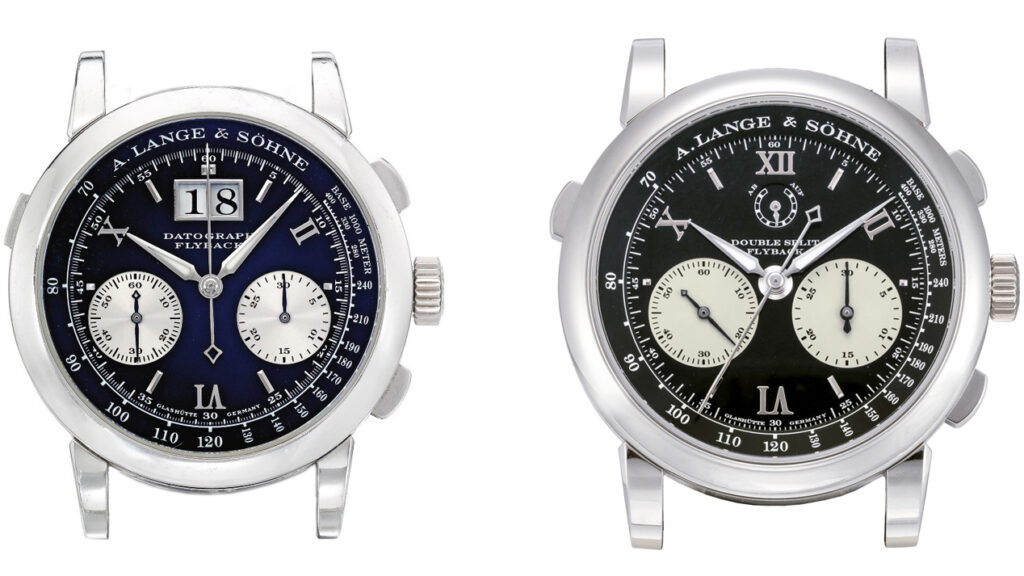
Datograph measures 39 mms in diameter whereas Double Split 43.2 mms. Hence, the proportions of the sub-dials had to be arranged accordingly. It can be easily observed that the sub-dials are significantly bigger than the Datograph to reduce the space above 6 o’clock. The big date was replaced by a very useful power-reserve indicator at 12 o’clock. The remaining empty area is nicely covered with a gold Roman XII and nicely balanced with below the center sub-dials. As the same with the Datograph, the applied Roman Numerals create an equilateral triangle, forming a focus point.
The galvanized solid silver dial is constructed on three steps. From outside to inside: Tachymeter scale, main dial and sub-dials. Indeed, the front side does justice to the movement depth… A. Lange & Söhne’s black on the Double Split is simply stunning. It is neither enamel nor lacquer; yet shockingly lively. The panda look blesses the Mighty Double Split (hats off to @GaryG_1) with a rather sporty look and broad, lumed hands further enhances the appearance. The color harmony conceived by the gold and blued steel hands are just perfect against the deep black background. The color arrangement also enhances the legibility. The hands are also slightly curved rather than just being straight, which undoutabtedly would cherish the careful eyes.
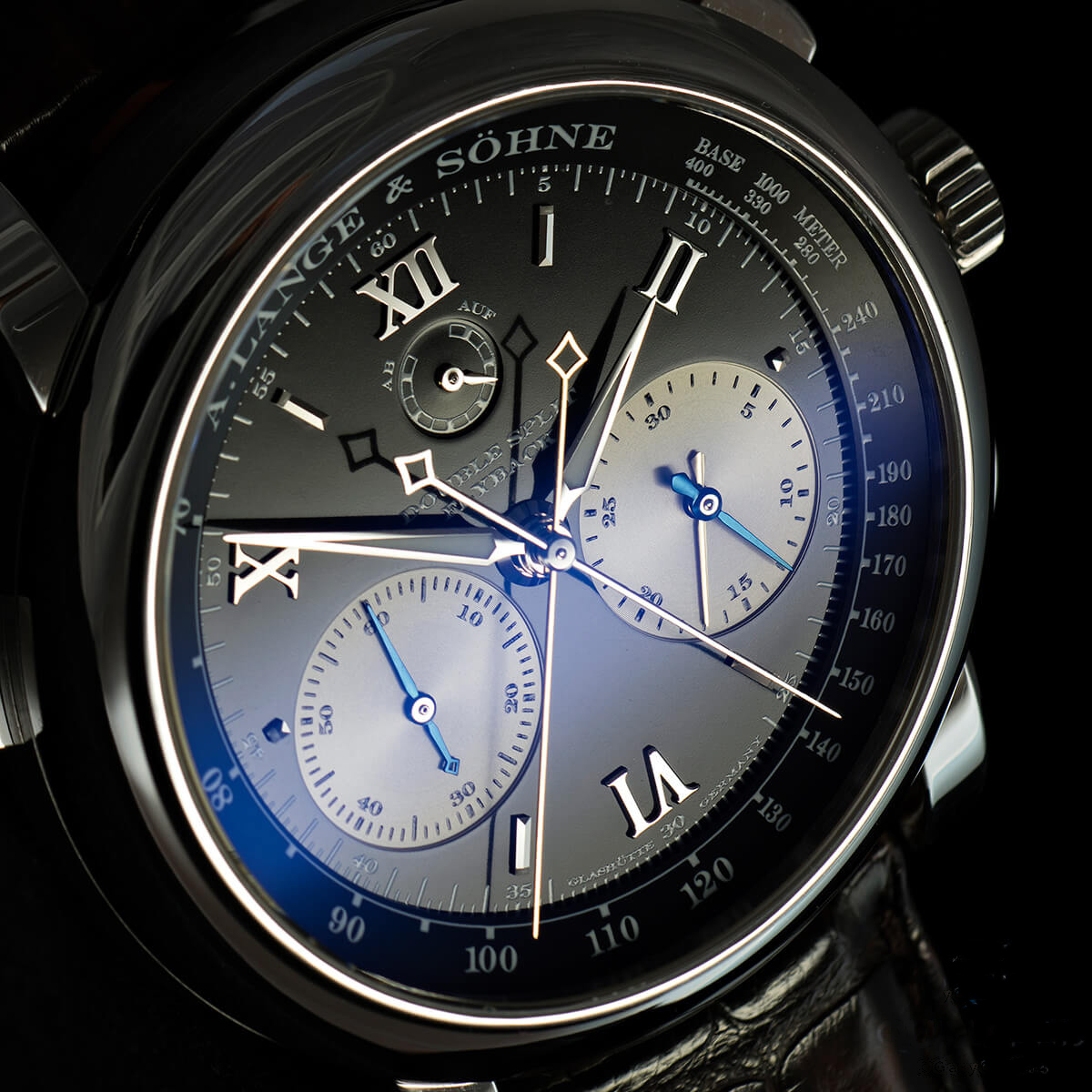
As a final note; rarely known, Double Split (404.035) went through a facelift between its introduction in 2004 during Geneva Watch Salon and later on production. Even though the concept was extremely well received, according to the people who were there at the time, the design was not optimal. Lange collected the feedback of retailers and modified the piece until the production.
Easily noticeable; the power reserve indicator as well as the tachymeter scale was overhauled. The logo was moved to the tachymeter scale and the Double Split within the sub-dial to the center. Moreover, apparently Lange wanted to match the beat rate (6 ticks every second) with the hash marks between seconds and this made the dial a bit crowded; thus removed during the overhaul. In my opinion, it resulted in a much better watch.
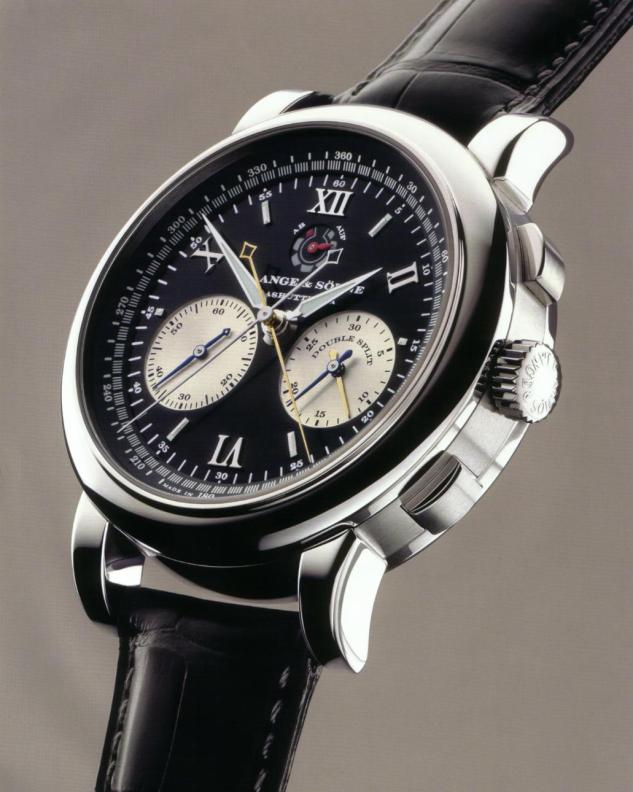
As a final note; rarely known, Double Split (404.035) went through a facelift between its introduction in 2004 during Geneva Watch Salon and later on production. Even though the concept was extremely well received, according to the people who were there at the time, the design was not optimal. Lange collected the feedback of retailers and modified the piece until the production.
Easily noticeable; the power reserve indicator as well as the tachymeter scale was overhauled. The logo was moved to the tachymeter scale and the Double Split within the sub-dial to the center. Moreover, apparently Lange wanted to match the beat rate (6 ticks every second) with the hash marks between seconds and this made the dial a bit crowded; thus removed during the overhaul. In my opinion, it resulted in a much better watch.
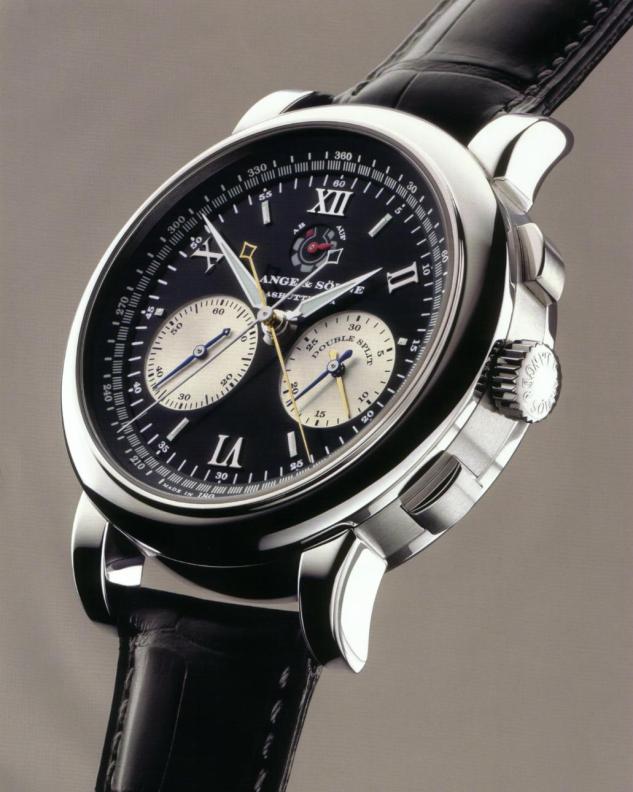
Caliber L001.1
Warning, this is going to be as deep as the movement itself.
As mentioned, A. Lange & Söhne Double Split is the world’s first double rattrapante chronograph. It achieves something that was never done before. Understanding how it works, albeit complex, is a true joy.
For me, the Double Split’s caliber L001.1 most certainly the most aesthetically constructed, finished, and joyful movement to look at. It is a waltz between the splendidly curved levers, hue of variety of metals and exemplary craftsmanship. Yes, it is unbearably thick for many; but it is valuable exactly because of this. There are many thick movements around, yet none is this impressive, immersive and characteristic. I may go as far and say, this is Michelangelo’s David of mechanical watch movements.
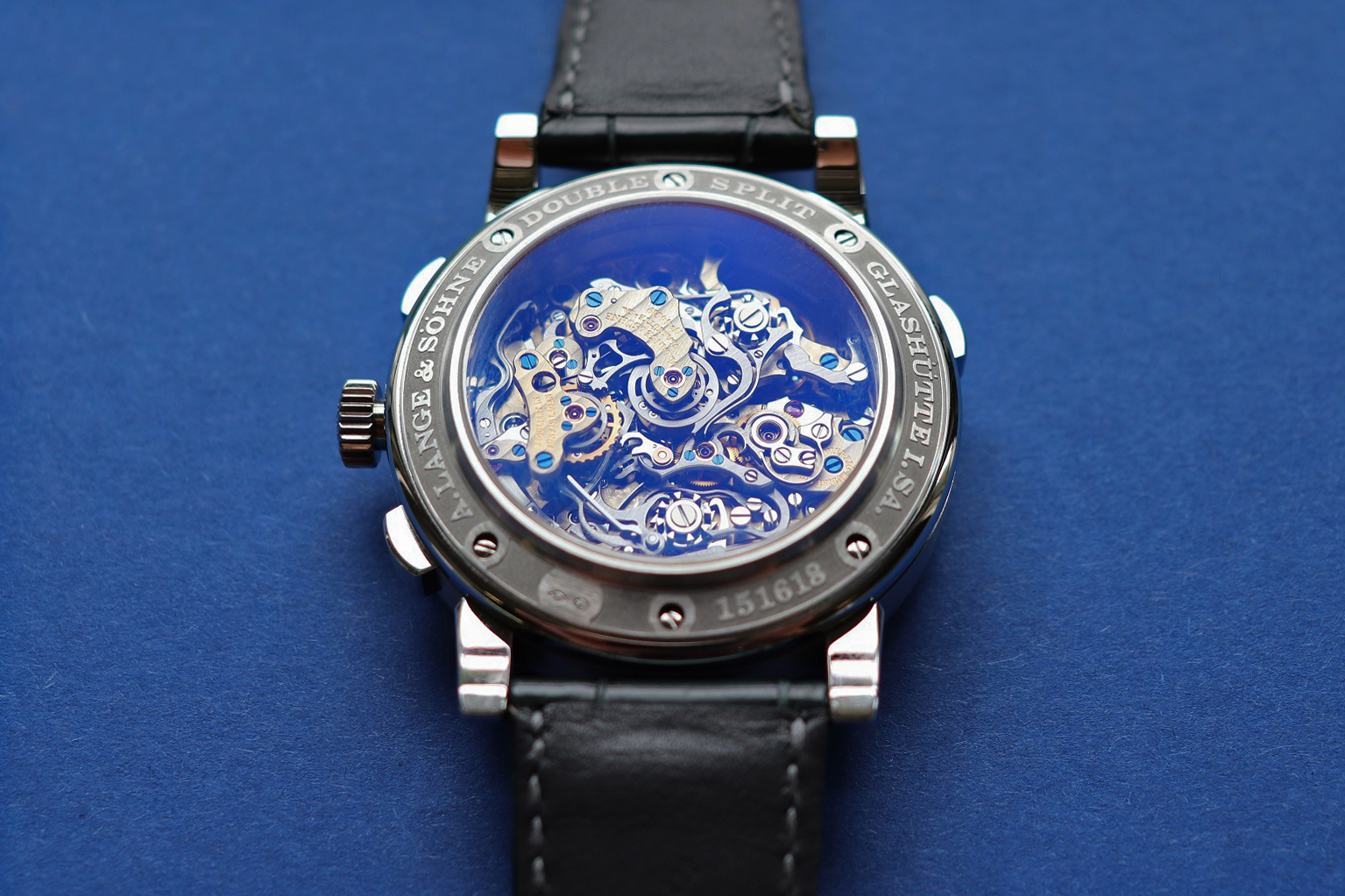
It bears all the A. Lange & Söhne and Glashütte watchmaking hallmarks such as hand-engraved balance cock, gold chatons, blued screws etc. with a myriad of finish techniques. The interplay between straight grained chronograph levers to flat polished column wheel, chamfered edges is just remarkable. It is a mechanical sculpture – nothing less. Although the modular construction blocks the beating heart view of the balance wheel and its engraved balance cock; it is a worthy sacrifice to observe hundreds of moving parts with full exposure.
The Double Split’s caliber L001.1 measures 30.5 mms in diameter and 9.5 mms in thickness. It beats at a traditional 3 Hz and boasts 38 hours of power reserve. It also houses the first in-house balance spring of A. Lange & Söhne.
Das Technik
A. Lange & Söhne’s Double Split starts to run with a press to the pusher at 2 o’clock. With the push, both chronograph hands starts to run. While running, the pusher at 10 o’clock splits the chronograph and minute hands while the gold hand continues to run. Another push to the 10 o’clock pusher once again, the silver hand (as well as the blued minute hand) catches the gold hand for a new measurement. The pusher at 4 o’clock is simply for the flyback or reset function. So, when operating this marvel of engineering, we’ll mostly deal with the pushers at 10 and 2 o’clock directions.
Now the important question: How the hell does it work?
Caliber L001.1 was conceived in 2001, right after the introduction and the success of the Datograph. It is basically a modular construction on three layers. Below the three-quarter plate we have the gear-train, chronograph is in the middle section and the double rattrapante addition on the third layer; which is easily identifiable with the so-called twin towers. However, in order to comprehend how the Double Split works, first, we must understand the chronograph.
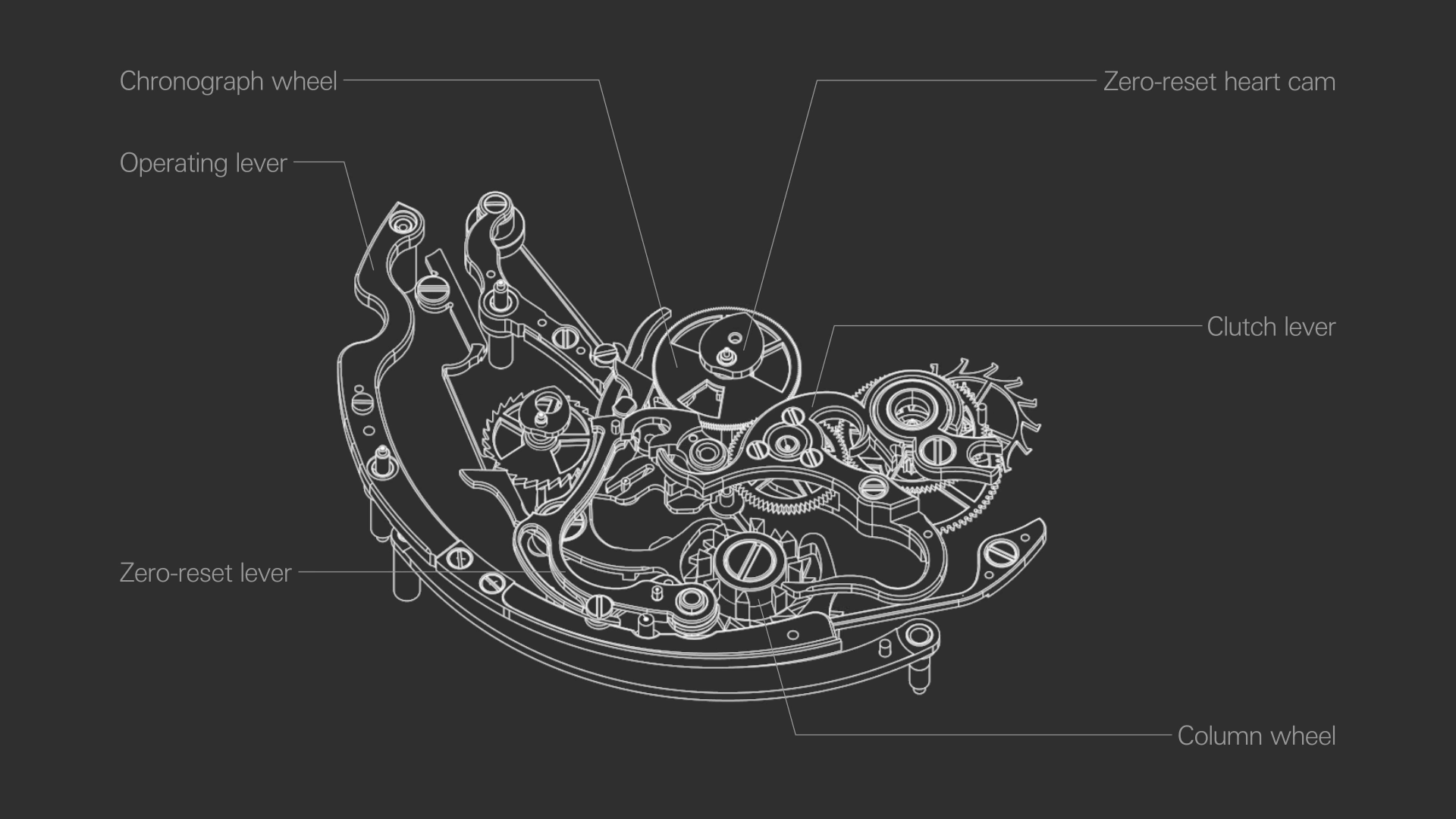
The processor of the chronograph is the column-wheel. It is the link between the pushers and the function we see. If you look closer, you are going to see that the clutch lever, zero-reset lever and the operating lever are all connected to it. The chronograph becomes active when the operating parts of the mechanism connects to the running movement. When the user presses the start button, column wheel spins forward and pushes the clutch lever’s tail in between the pillars. With this motion, the clutch lever moves horizontally and meshes with the chronograph wheel. To stop, pressing the button again, the clutch lever sits on the pillar again and disengages from the chronograph mechanism.
The flyback lever works with a similar principle. A heart lever presses against the claw shaped flyback lever, which contacts the heart cam on top of the chronograph seconds’ wheel and the hand on the dial side flies back to zero.
The Double Split however, simply has two of these and the interaction is something to behold.
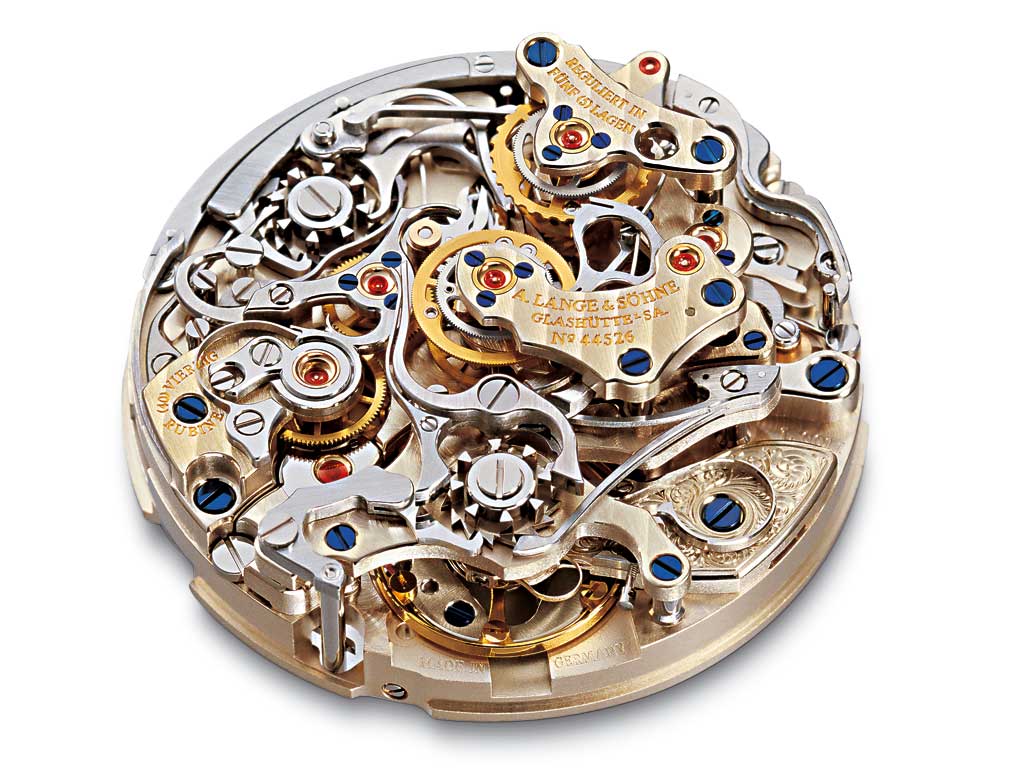
The bridge at 1 o’clock is for rattrapante minutes and the one in the center is for rattrapante seconds. A rattrapante chronograph has two hands that sit on interlocking shafts. In the case of the double rattrapante mechanism, this arrangement exists twice: two seconds hand and two minutes hand. These two shafts rotate together. Simply put, when you activate the rattrapante while the chronograph is running, you actually block the rattrapante gear. Upon release, just like the flyback function mentioned above, the rattrapante wheel spins to rejoice the main chronograph hand and sits on top of it.
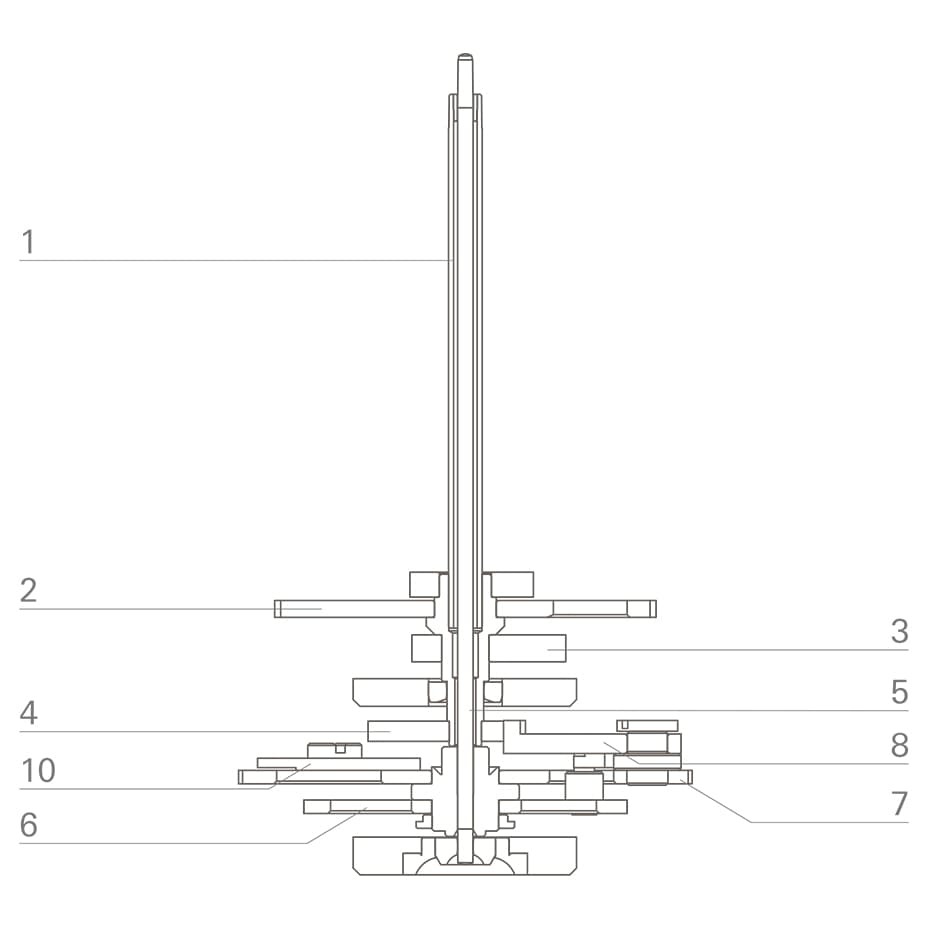
The hollow chrono centre arbor on the outside (1) carries the chrono sweep-seconds hand. It is driven by the chronograph centre wheel (2 – the same wheel at the l951.1 diagram two above). It is rigidly connected to the zero-reset heart cam (3 – also in the l951.1 diagram) of the chronograph centre wheel and the heart cam (4) of the rattrapante center wheel. The heart cam makes it possible to reset the hand to zero by taking the shortest route possible (left or right) – or as the case with rattrapante, to synchronize it with the chronograph sweep-seconds hand.
The rattrapante hand, which is superimposed on the chrono sweep-seconds hand, is attached to the inner rattrapante centre harbor (5). This arbor holds the disengagement wheel (6) and the rattrapante centre wheel (7) to which the rattrapante heart lever (8) is attached. (Figure 2)
Starting and stopping the Lange Double Split:
In the basic position, the rattrapante heart lever (8) is pressed against the flat side of the heart cam (4) of the rattrapante wheel via a spring (9). This connects the otherwise separately movable chrono centre arbor (1) and the rattrapante center arbor (5). So that when the chronograph hand starts to move, rattrapante moves as well.

When the rattrapante pusher is activated, the column wheel (11) rotates one step. Now, the split-seconds clamp (12) closes and arrests the rattrapante centre wheel (7). An arresting spring (13) concurrently seizes and stops the rattrapante minute counter while the two chronograph hands (seconds and minutes) continue to move. When the pusher is pressed again, the rattrapante clamp (12) opens and the minute arresting spring (13) is pushed aside. Thus, the rattrapante hand instantly joins the running chronograph hands.
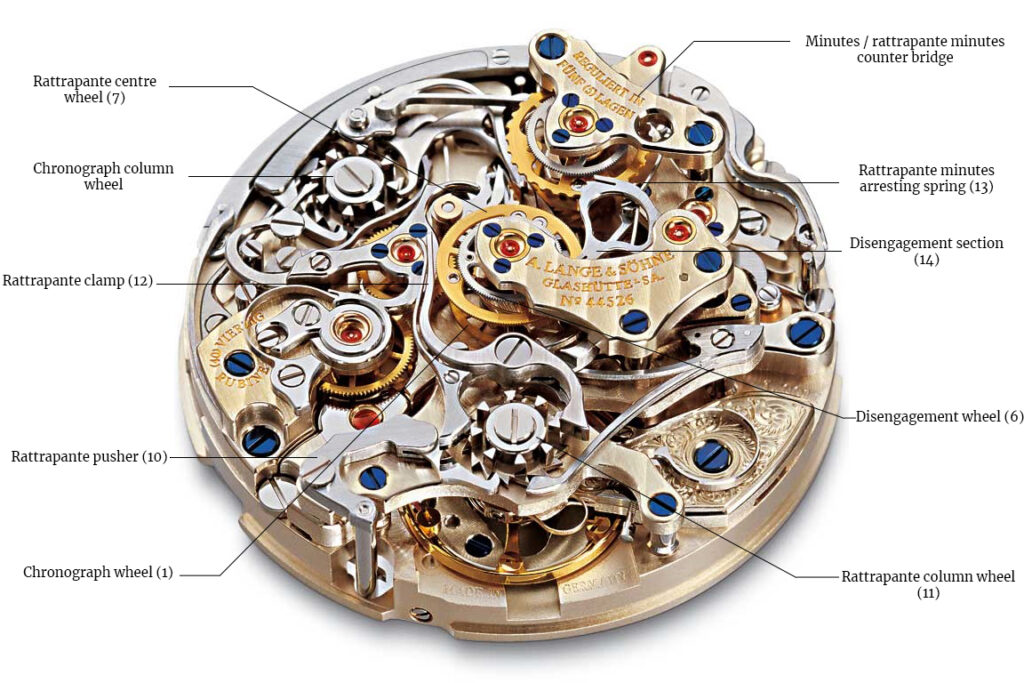
In addition, Double and Triple Split boasts a patented “disengagement mechanism”. A. Lange & Söhne describes the system as follows:
In the regular rattrapante mechanisms such as Tourbograph or 1815 Rattrapante Perpetual Calendar, as the chronograph hands continue to run while the rattrapante hands are stopped, the rattrapante heart lever (8) would rub against the rattrapante heart cam (4) of the rattrapante center wheel, which continues to run along with the chrono centre arbor (1). This in return causes friction therefore loss of amplitude. (Figure 3)
For the Double Split, actuating the pusher (10) also pivots the disengagement segment (14) inward. This motion rotates the disengagement wheel (6) by about 20 degrees in the other direction. The bottom side of the wheel carries a pin that when rotated in the opposite direction swings the rattrapante heart lever (8) out of the engagement zone of the heart cam (4) of the rattrapante center wheel thus the chronograph runs smoothly.
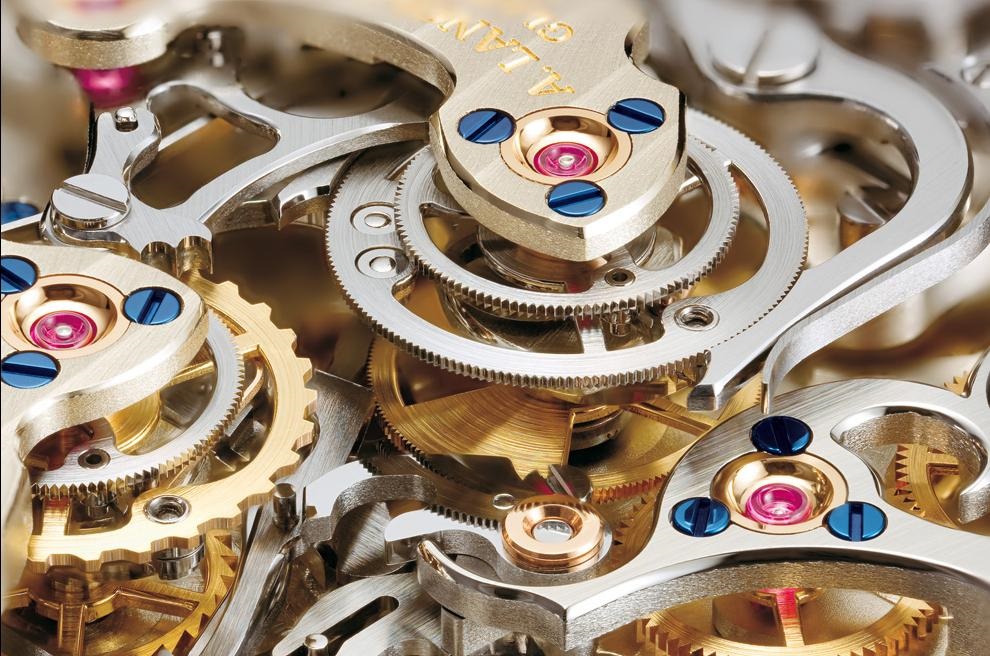
Disengagement wheel (top) in between the rattrapante clamps, rattrapante wheel (middle, silver color), and chronograph wheel (bottom, golden color)
On top of all these mind boggling engineering, Double Split features a flyback system and a precisely jumping minute counter. Within the history of more than 180 years, Double Split and later on the Triple Split are the two most advanced chronographs, ever.
PS: The disengagement mechanism is not exclusive to A. Lange & Söhne. Patek Philippe also has a brilliant example on their caliber CHR 29-535 PS
Double Split - Pink Gold
Following 6 successful years, A. Lange & Söhne discontinued the legendary platinum Double Split reference 404.035 and introduced the facelifted pink gold version in 2010.
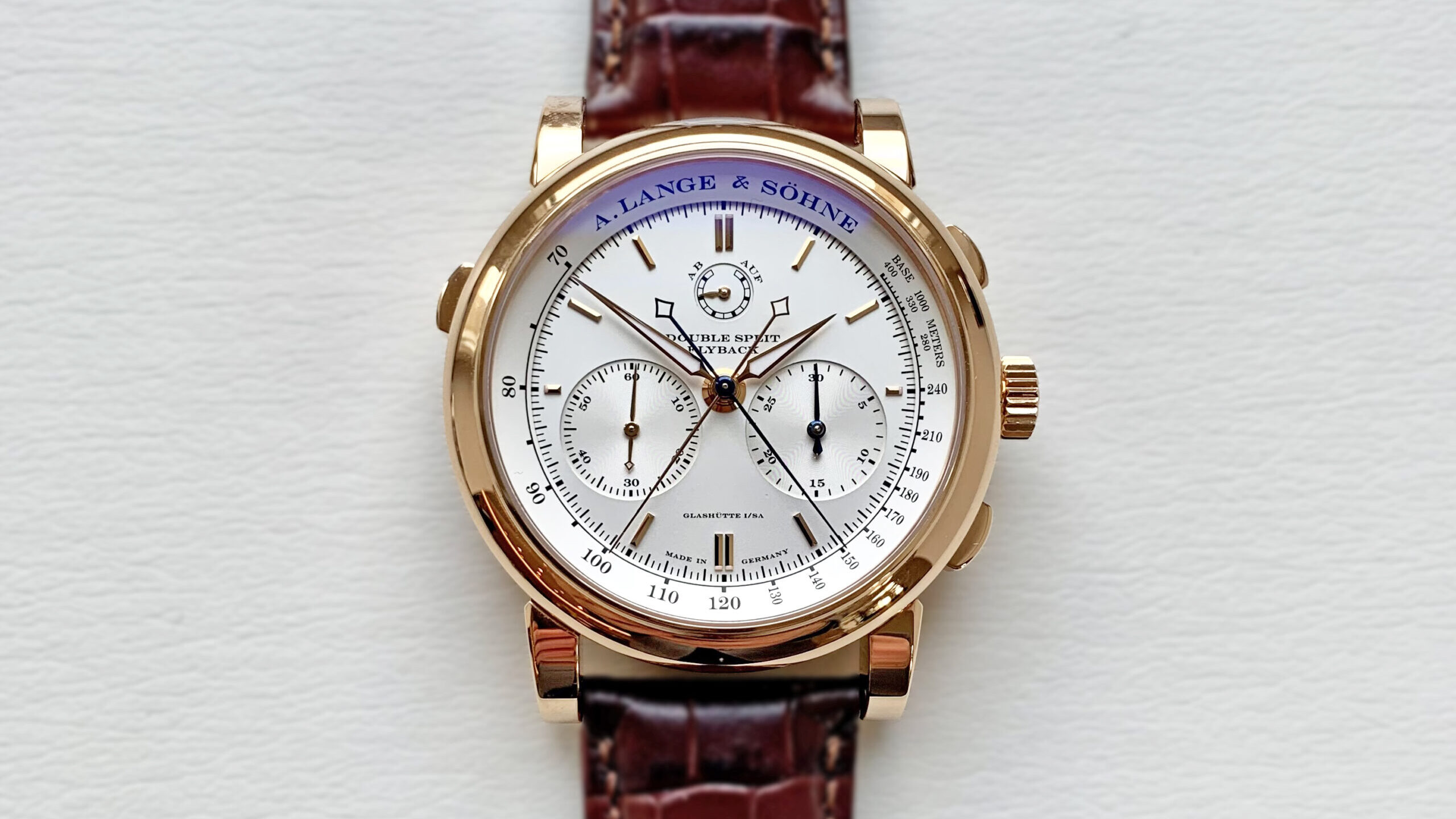
As mentioned in the Datograph Up/Down article, during the late 2000s and early 2010s, A. Lange & Söhne went through a management change. This in return brought an easily noticeable shift in design. A. Lange & Söhne became less baroque so to speak, started to use more clear lines, ditched Roman Numerals or m shaped hashmarks etc. on a mission to modernize itserlf.
For example, other than the Double Split, the brand updated 1815 chronograph as well as the Datograph Perpetual. Double Split lost its Roman Numerals (as happened to Datograph in 2012), 1815 chronograph its vintage pulsometer… These adjustments brought a cleaner look, alas in exchange of a big part of their character. The pieces are still beautiful but not as striking. The second generation Double Split is a rather romantic piece – albeit that is something that the Double Split should not have been.
As with all prior 2018 – 2019 A. Lange & Söhne pink gold cases, the Double Split reference 404.032 features a fully-polished case as opposed to the reference 404.035’s alternating finish. This in return departs from the previous striking distinction between the lugs and the case, and results in a calmer, less aggressive appearance. I’d hated this should it be the case for the platinum / dial version but this one actually suits the reference 404.032’s already trimmed design.
The case measurements as well as the mechanics stayed the same.
Buying a Double Split
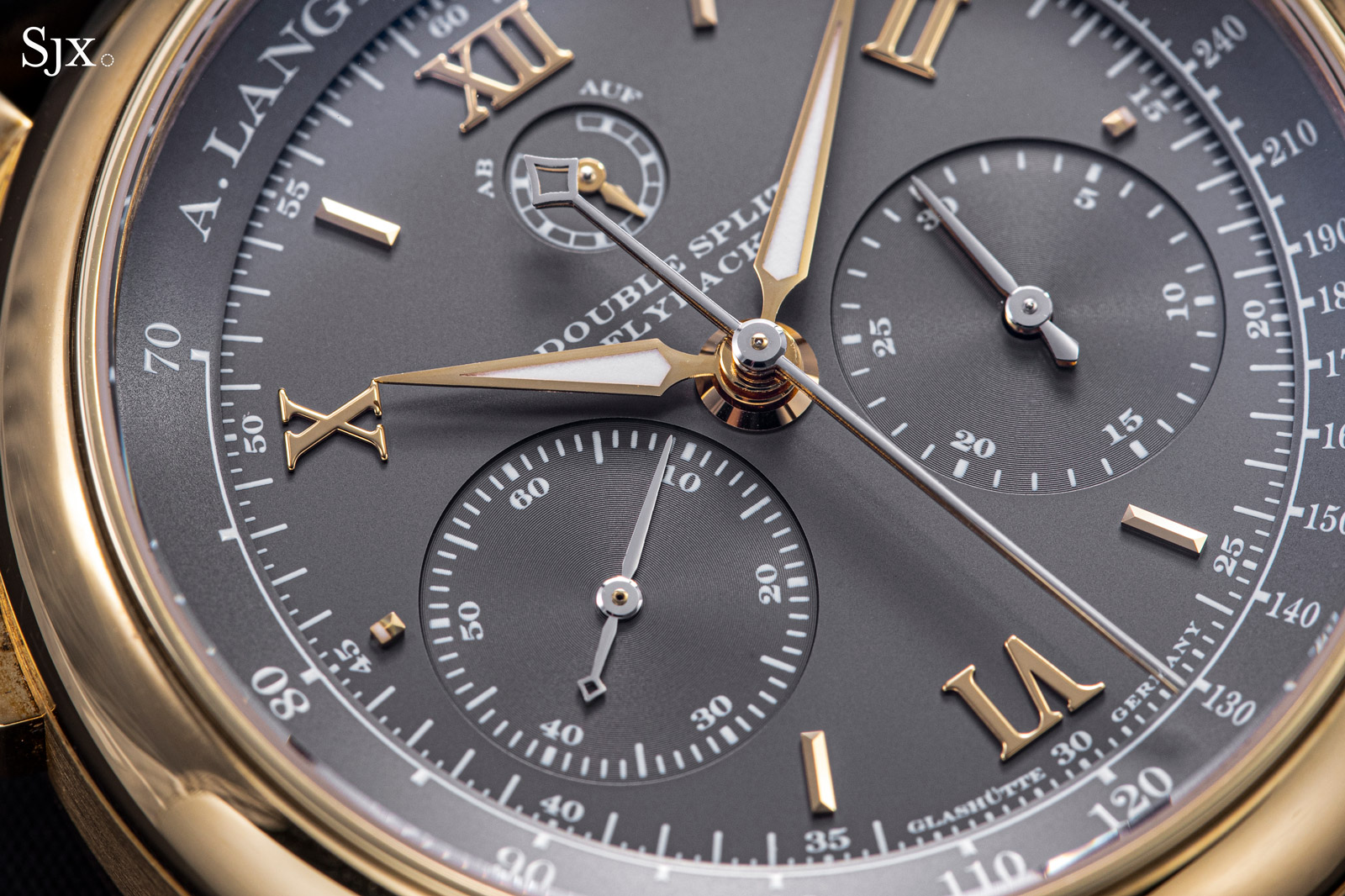
A. Lange & Söhne Double Split “Japan” Edition, limited to 10 pieces. Sold at Phillips HK May 2022 for $192k ( all in). Brilliant capture by SJXwatches.
When introduced in 2004, the retail for the reference 404.035 was $97k. It went through a hike of about 30% in 6 years and discontinued at $126.8k. Indeed, pricing the innovation is rather difficult and the price looks understandable even better if one accounts the competition. Sadly, the pre-owned market prices did not follow this hike.
I believe the foremost reason for the lack of demand might be the lack of comfort. Double Split is not an easily wearable watch. Most collectors I had the honor to know of buy this spectacular piece for the engineering and for display rather than putting on the wrist. This in return, shrinks the potential market size therefore prices. It is like 50 mms in diameter and 20 mms thick A. Lange & Söhne Grand Complication; unfortunately not a wristwatch.
Throughout the years, the pre-owned platinum Double Split prices have been stable between $60 – 70k. However, as of February 2021, the prices have been slowly creeping up just like other early A. Lange & Söhne pieces. Come to June 2022, we see that the Double Split platinum is listed at the north of $100k. In my humble opinion, both with its watchmaking virtue, its looks and importance, the Double Split is still a bargain.
One final note: There is a unique stainless steel example made for an A. Lange & Söhne executive around 2008 which was sold through Christie’s in 2013 for CHF 461K. Through the article stainless steel A. Lange & Söhne watches, you can read all about these rare / unique pieces.
Thank you.
I hope this was a valuable guide for whomever is looking for a Double Split or just want to learn the details and history of these pieces. If you’d like to chat, sell or buy a Double Split, please kindly reach out to me via [email protected]
Please feel free to contact:
Follow Langepedia on Instagram:
Watch “A. Lange Story” Documentary, in partnership with WatchBox:
FAMILIES / COMPLICATIONS
STAY IN TOUCH
Sign up for the newsletter to get to know first about rare pieces at Marketplace and in-depth articles added to the encyclopedia, for you to make the most informed choice, and first access!